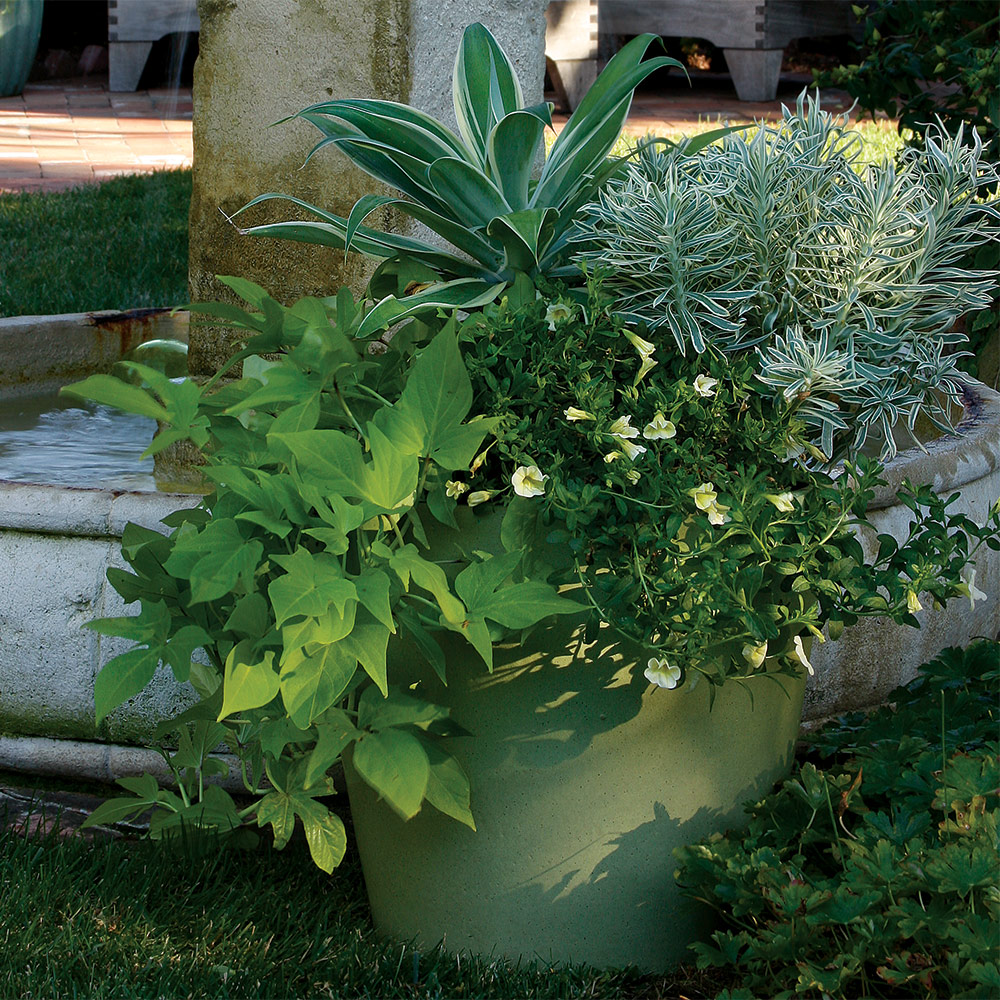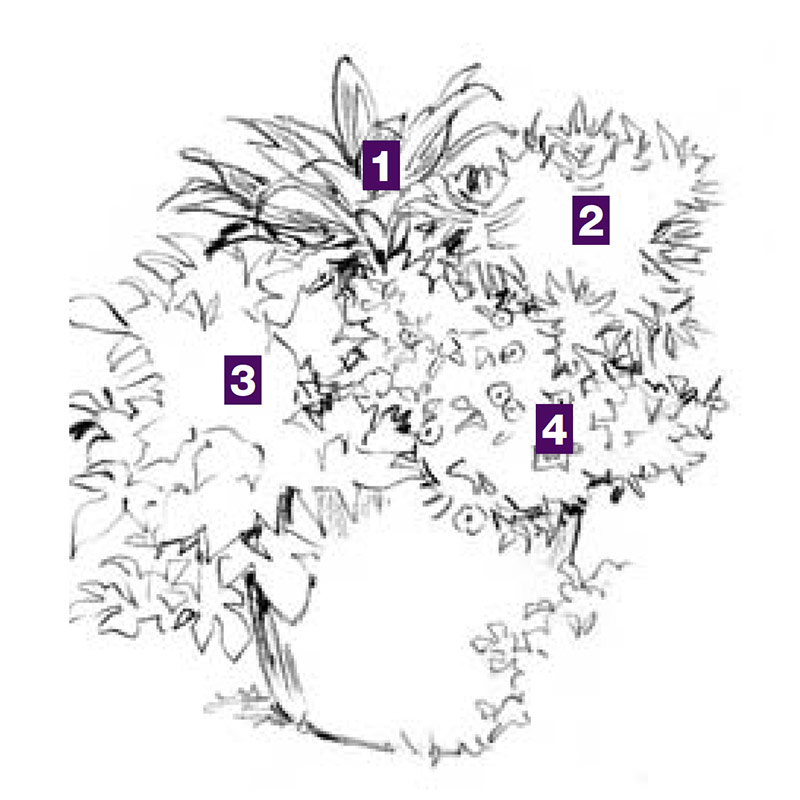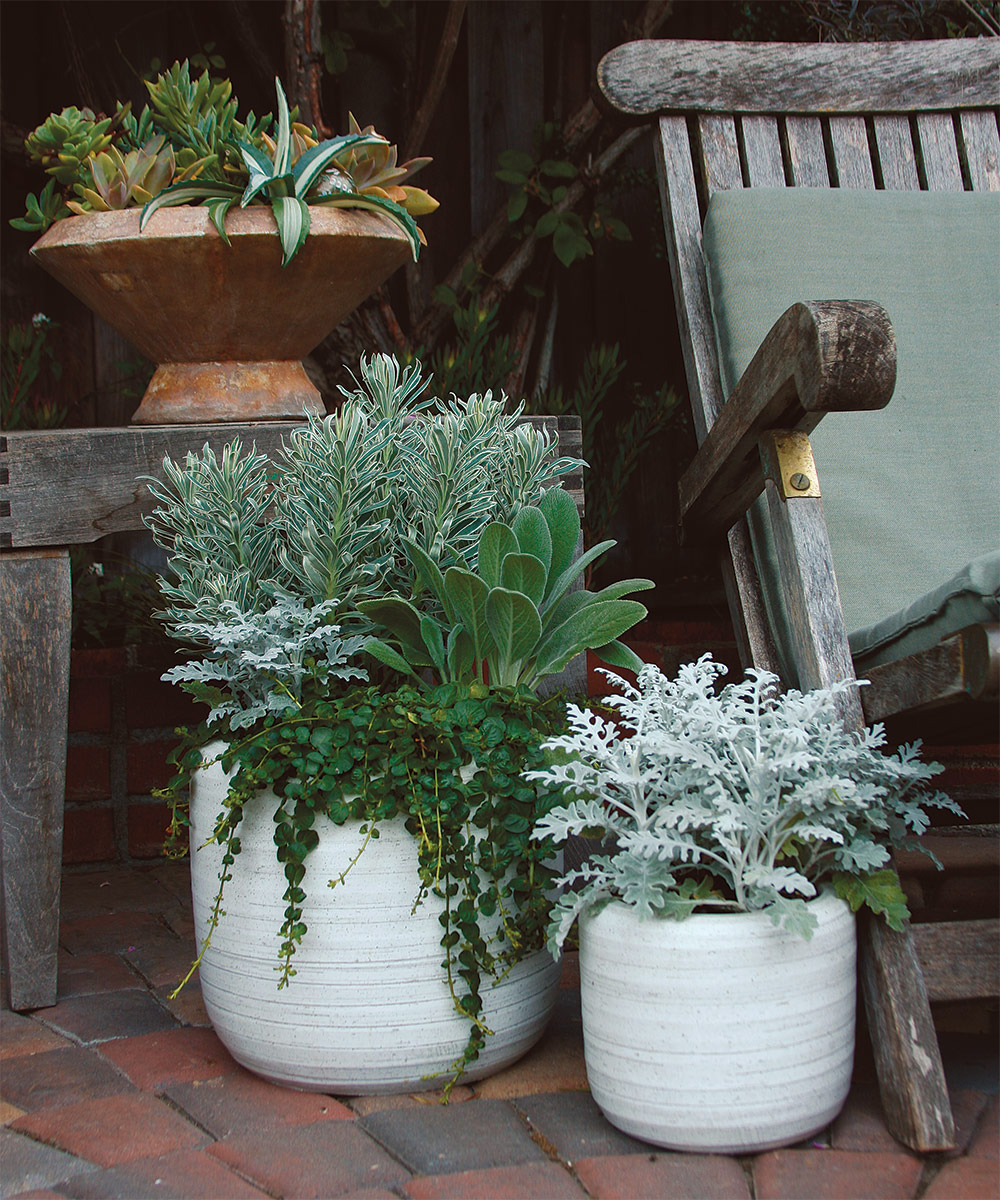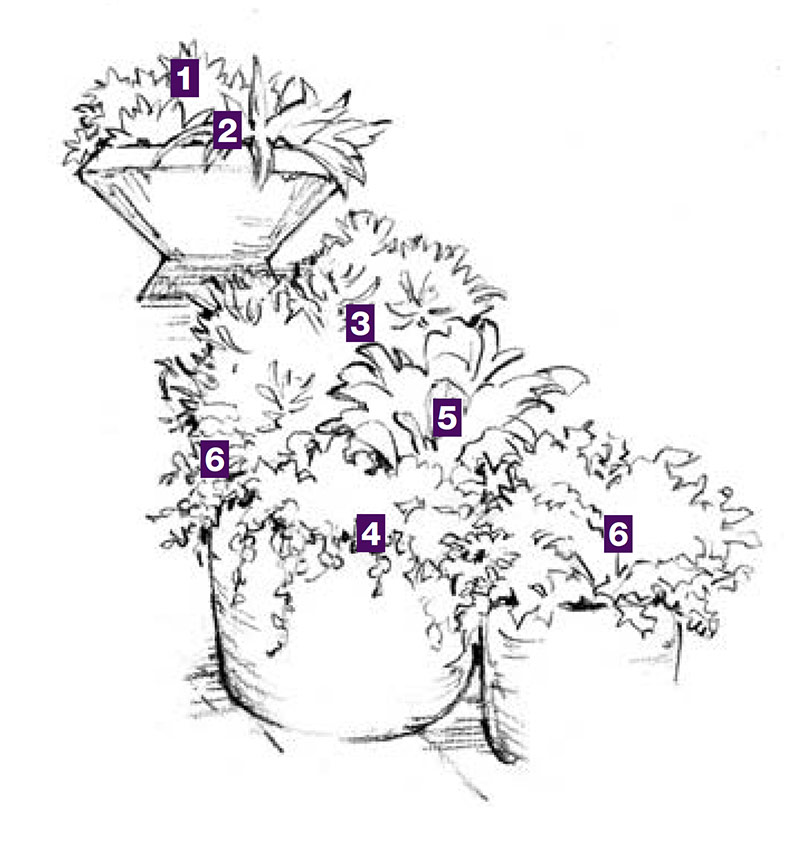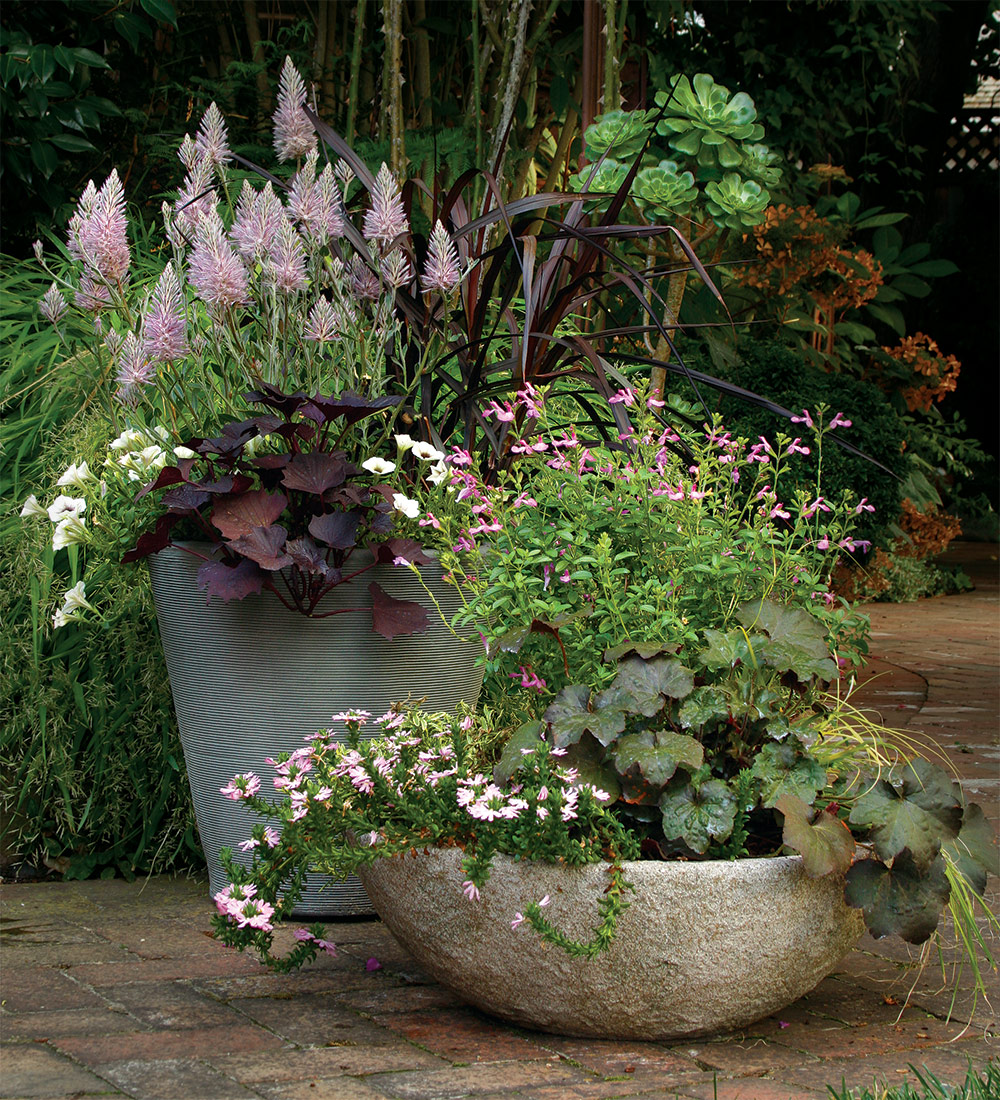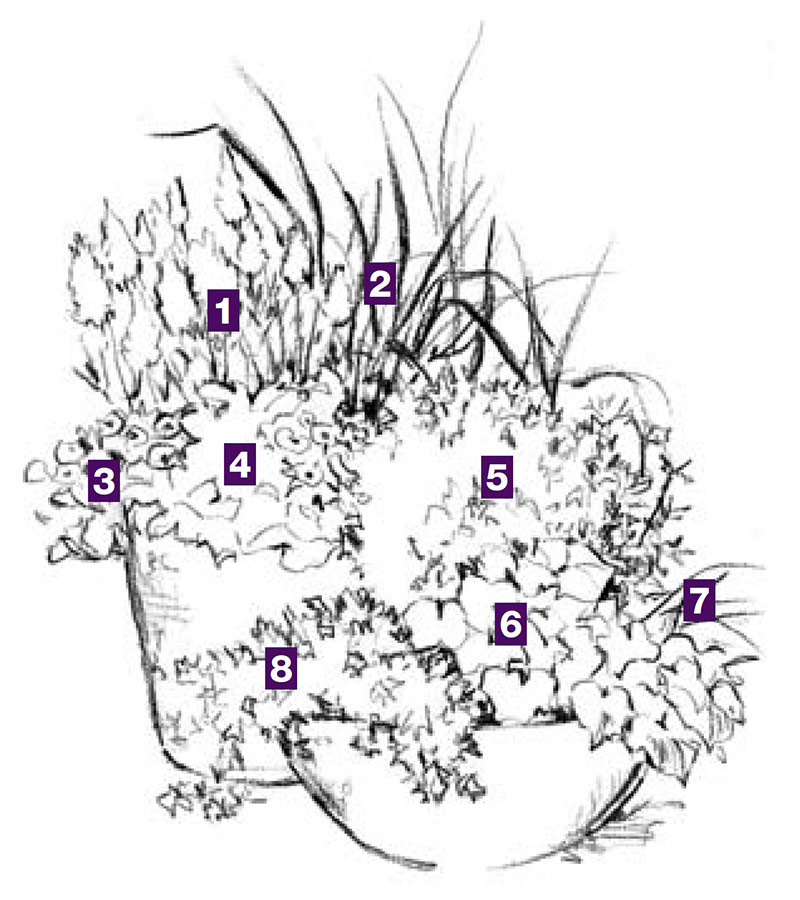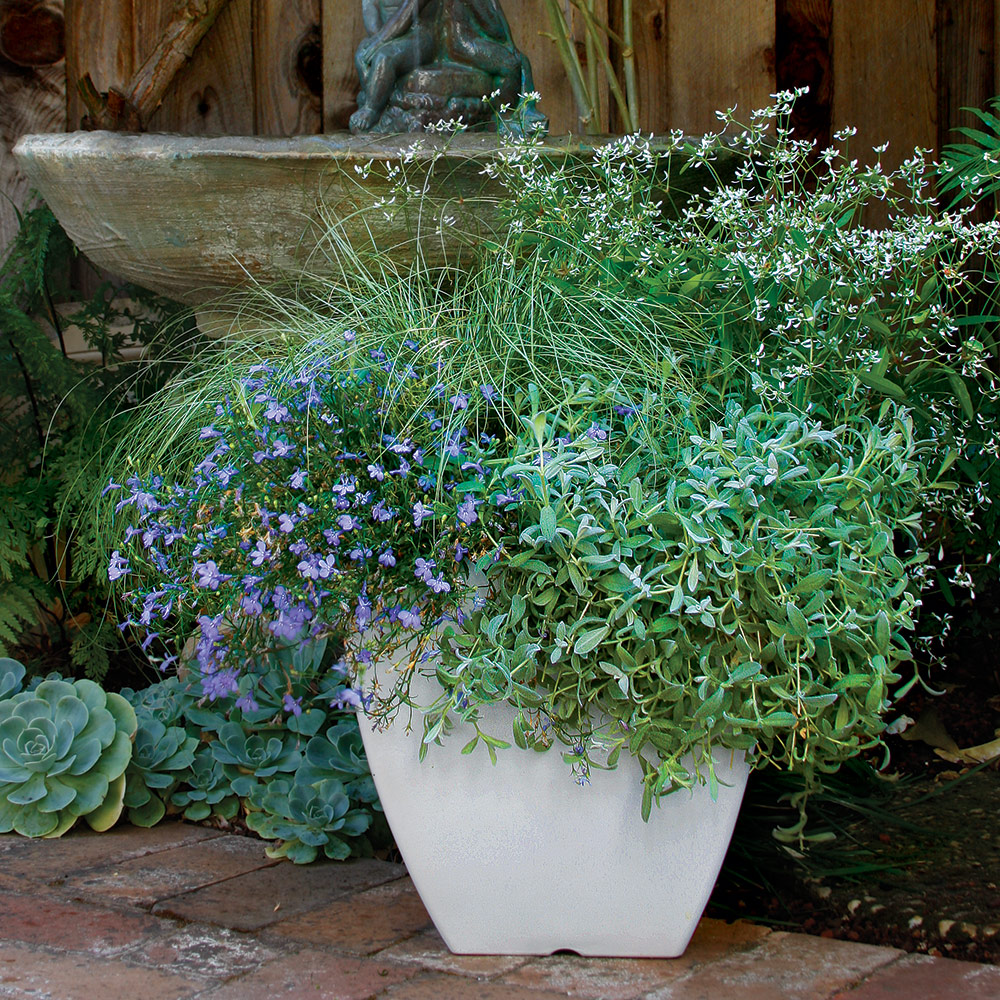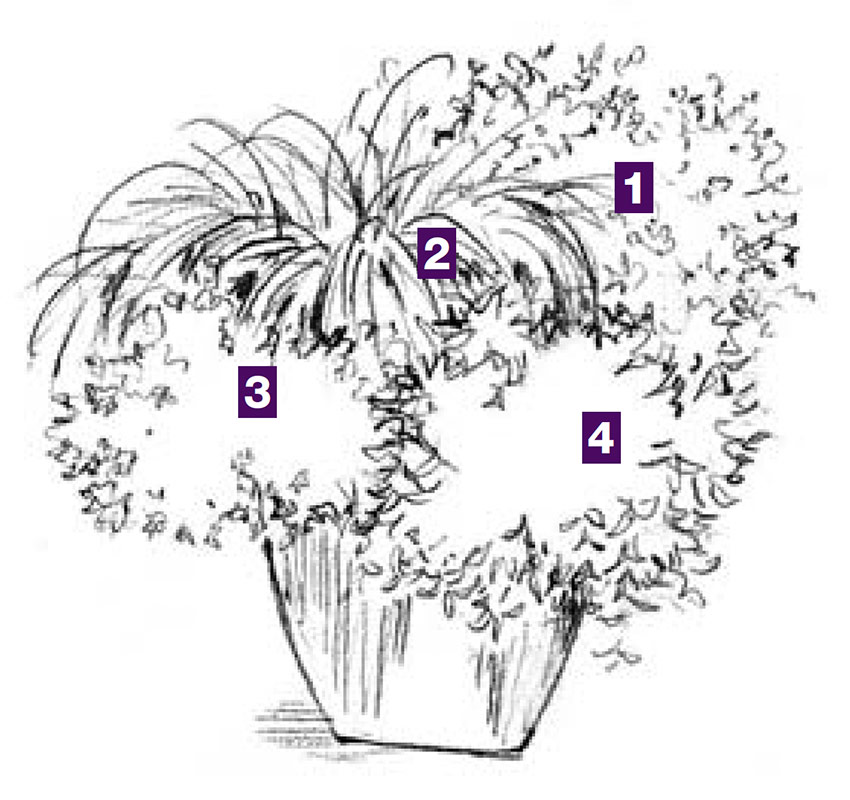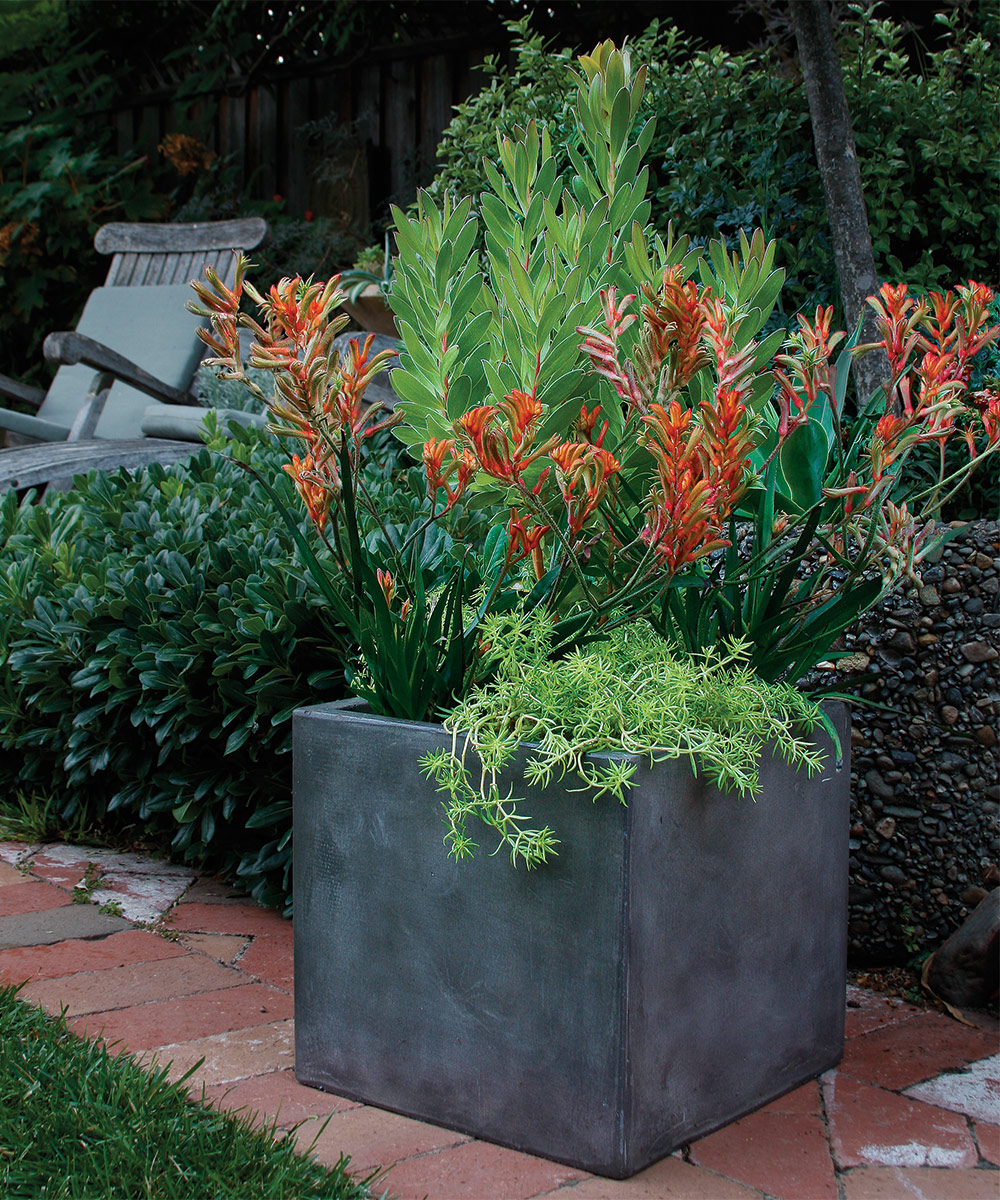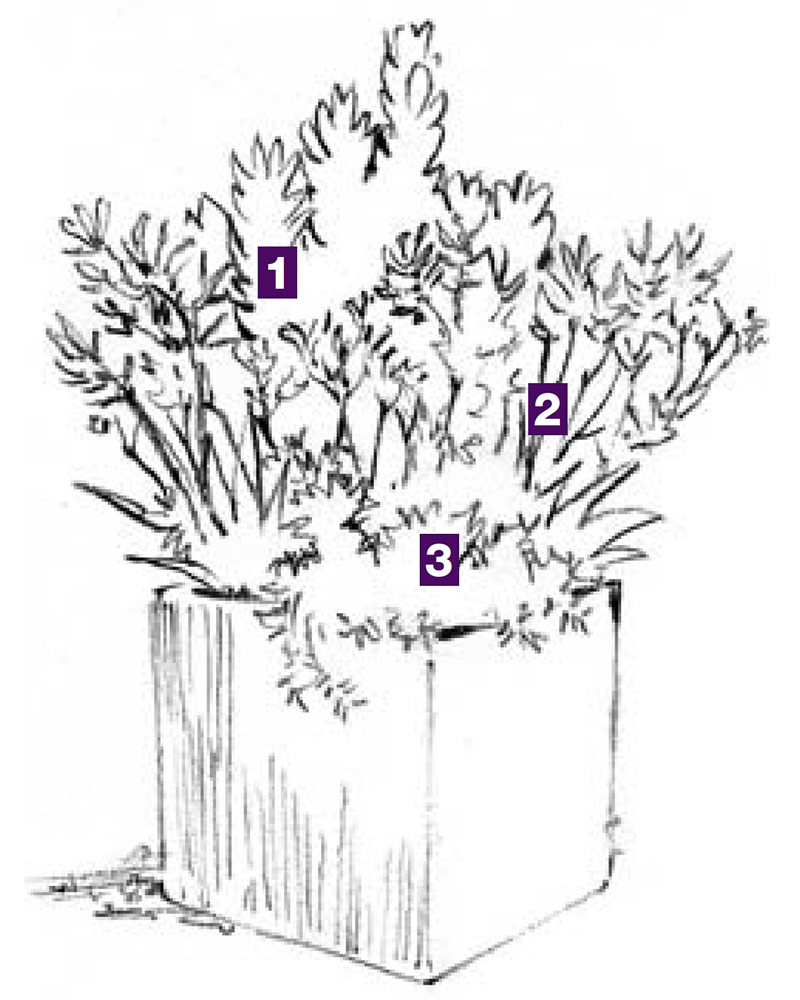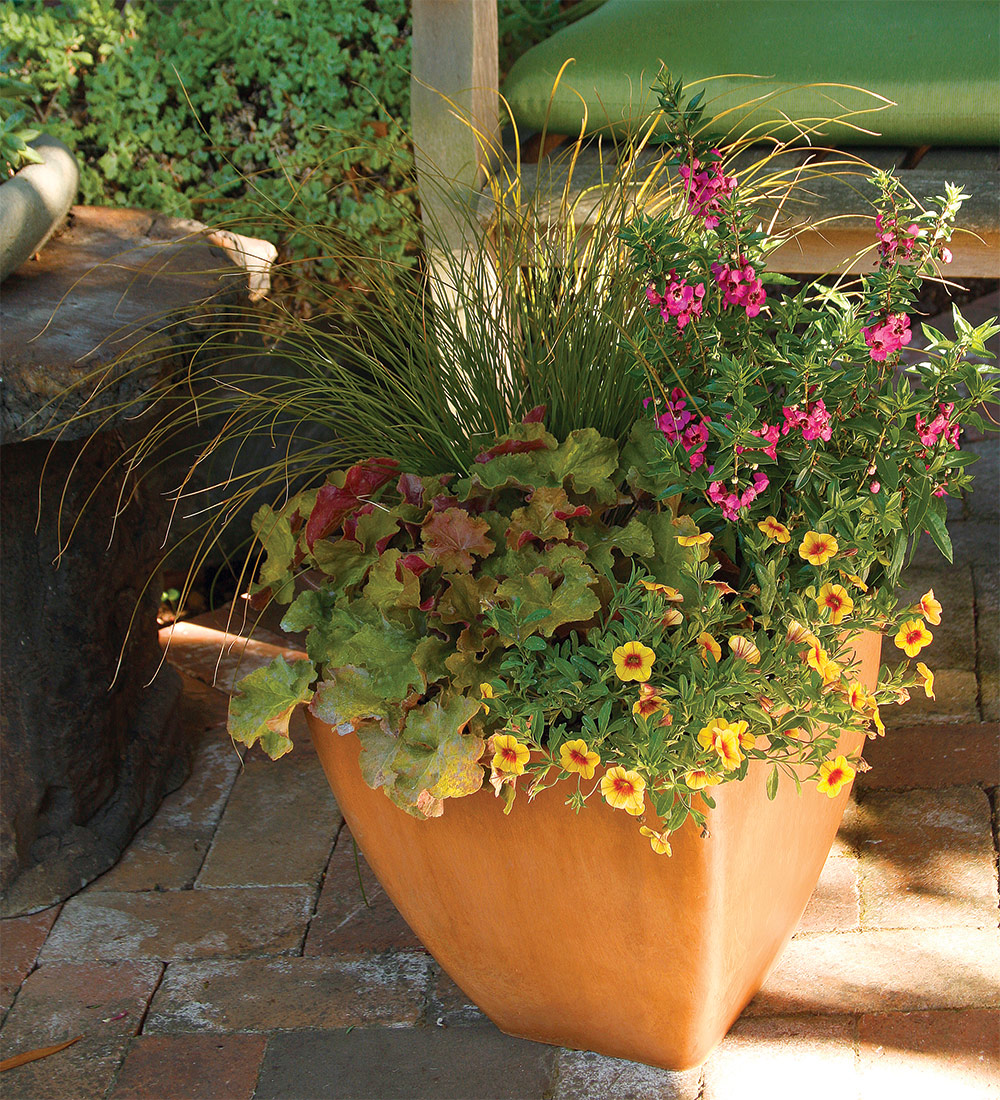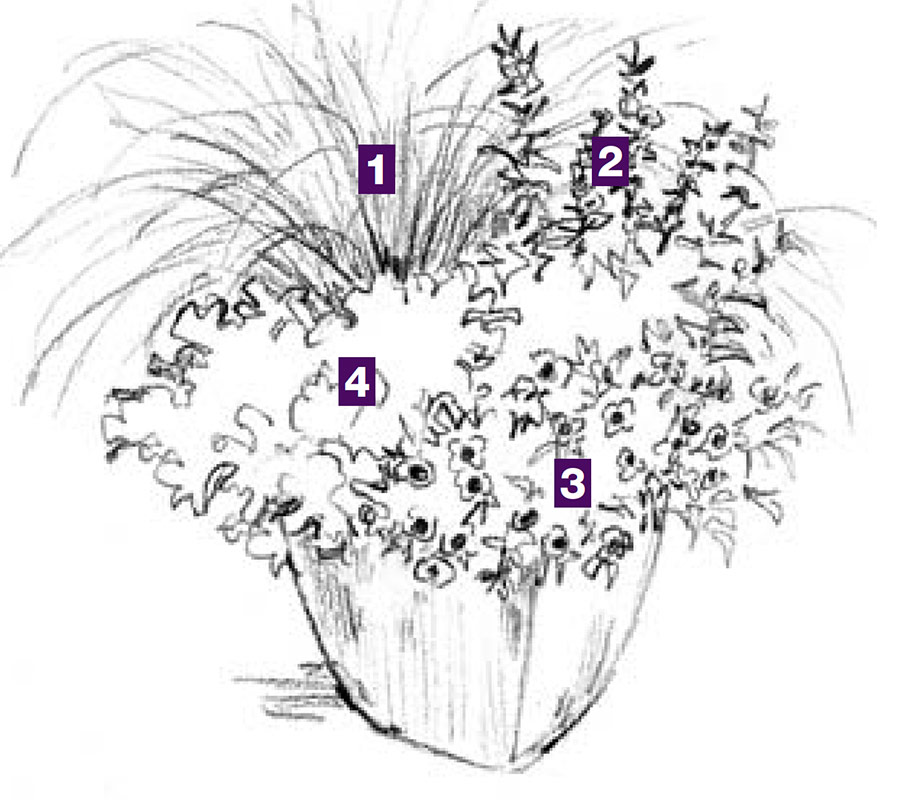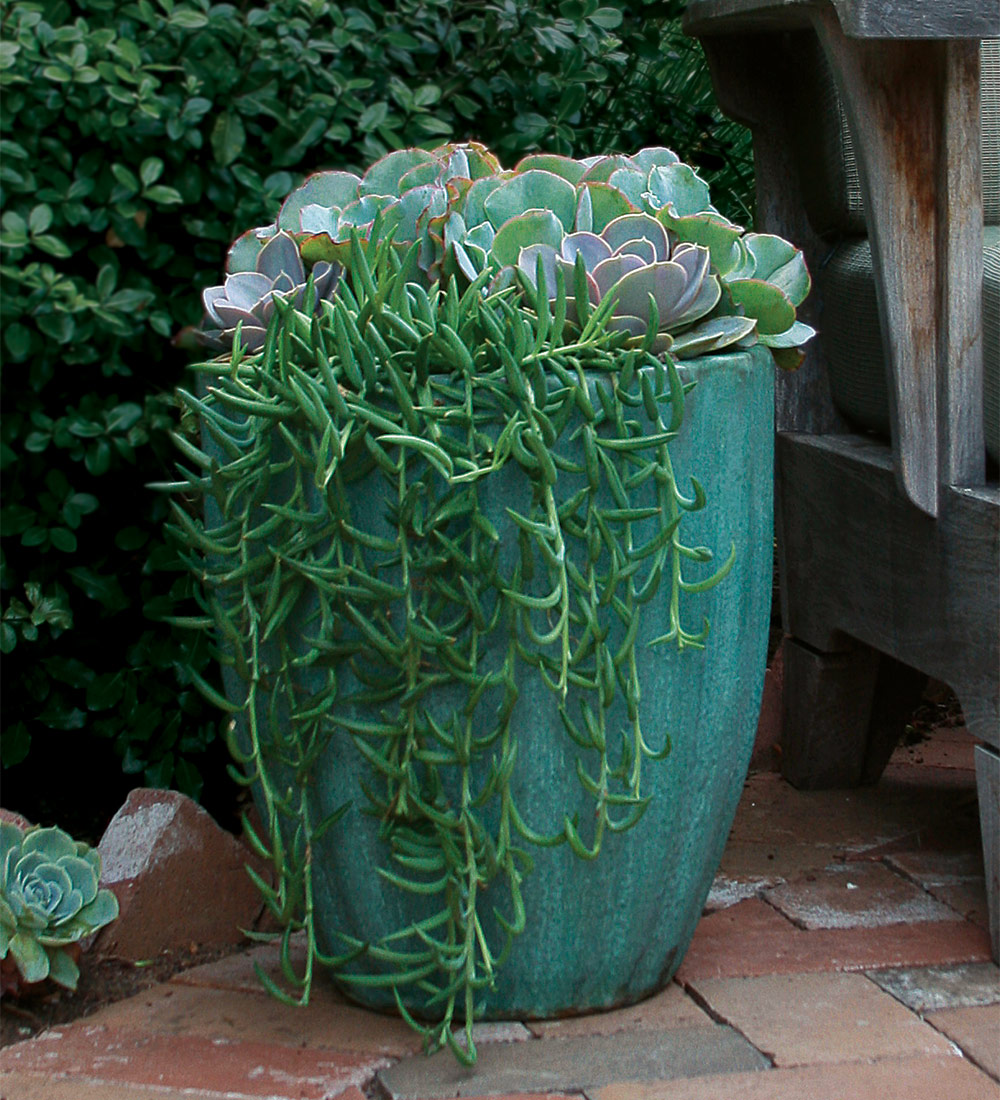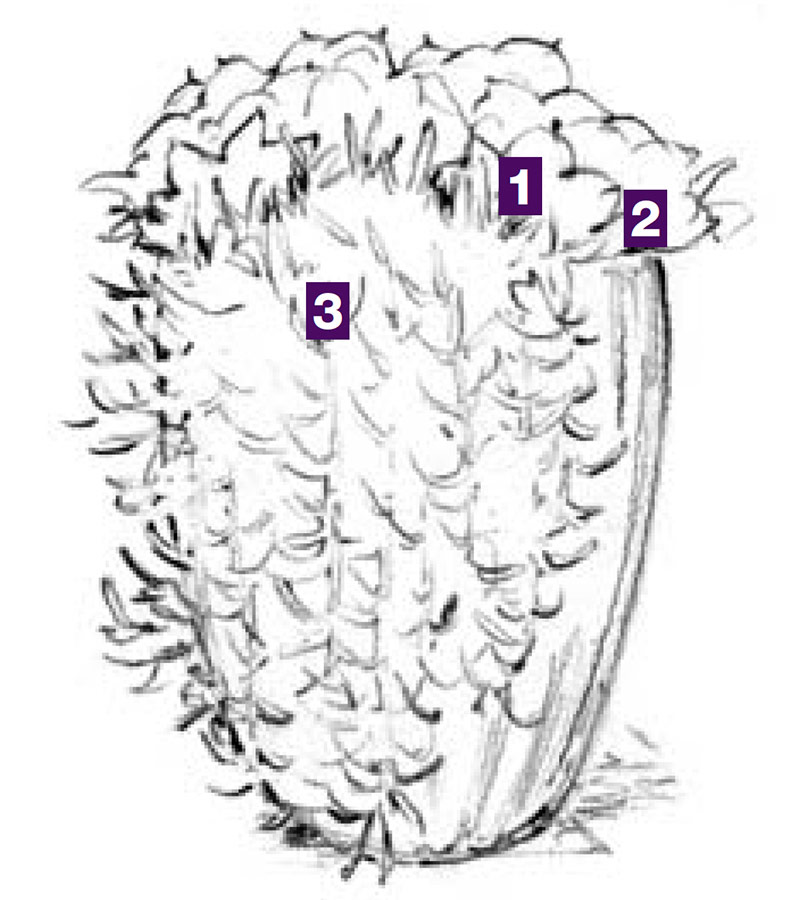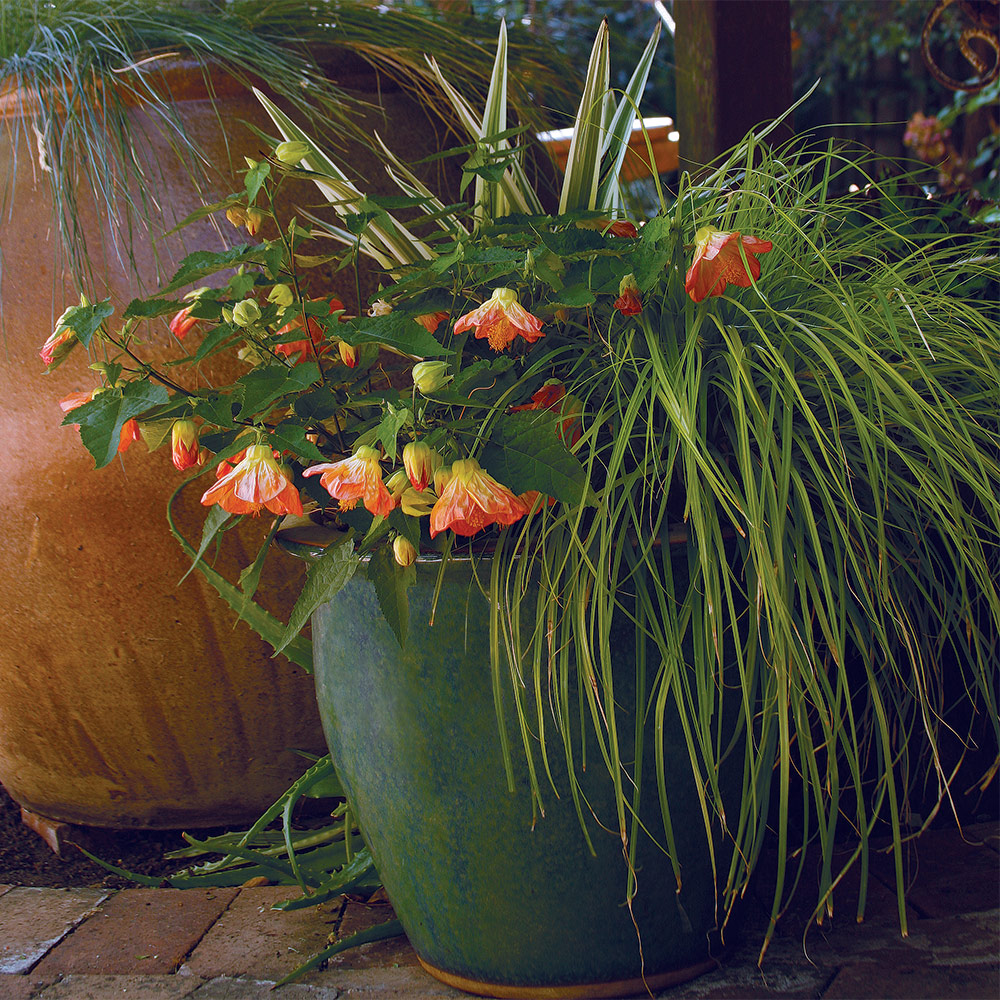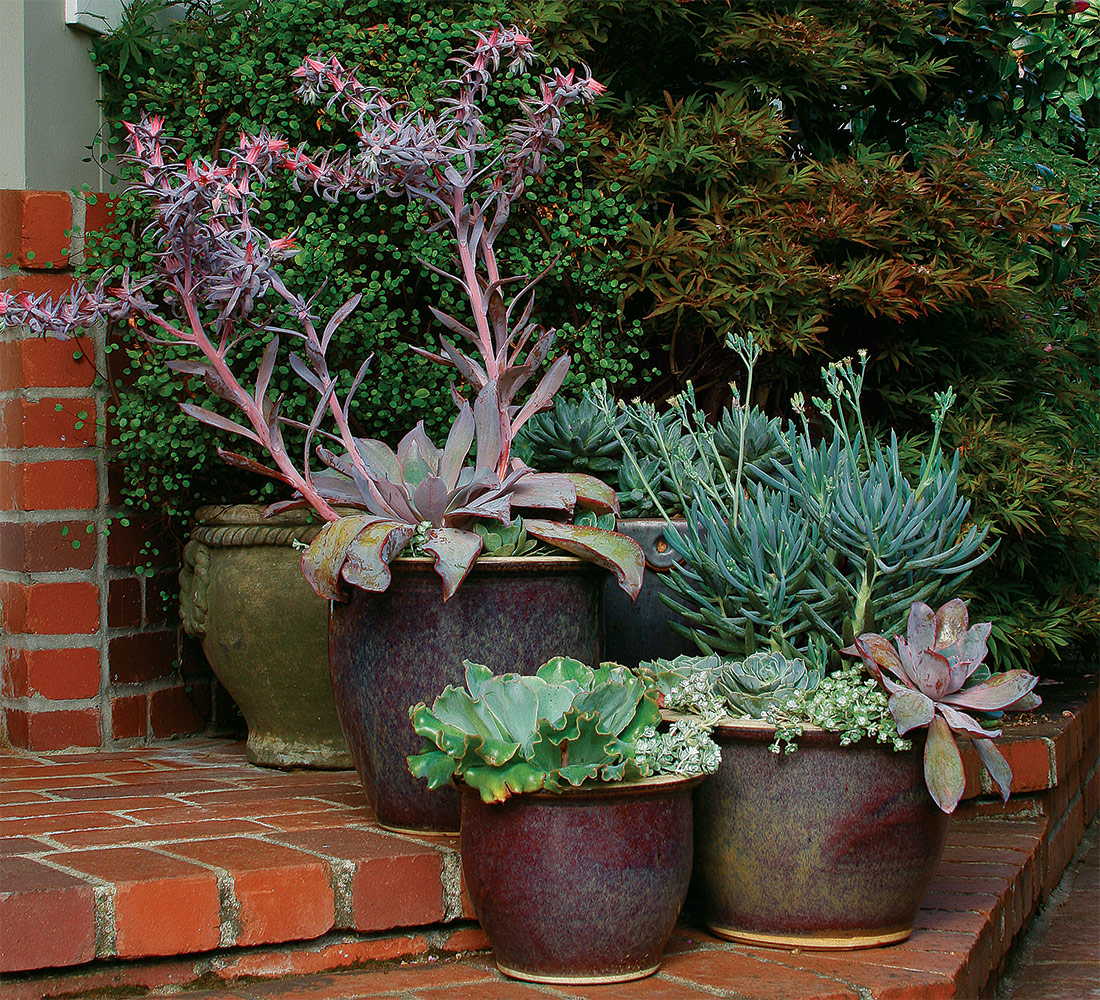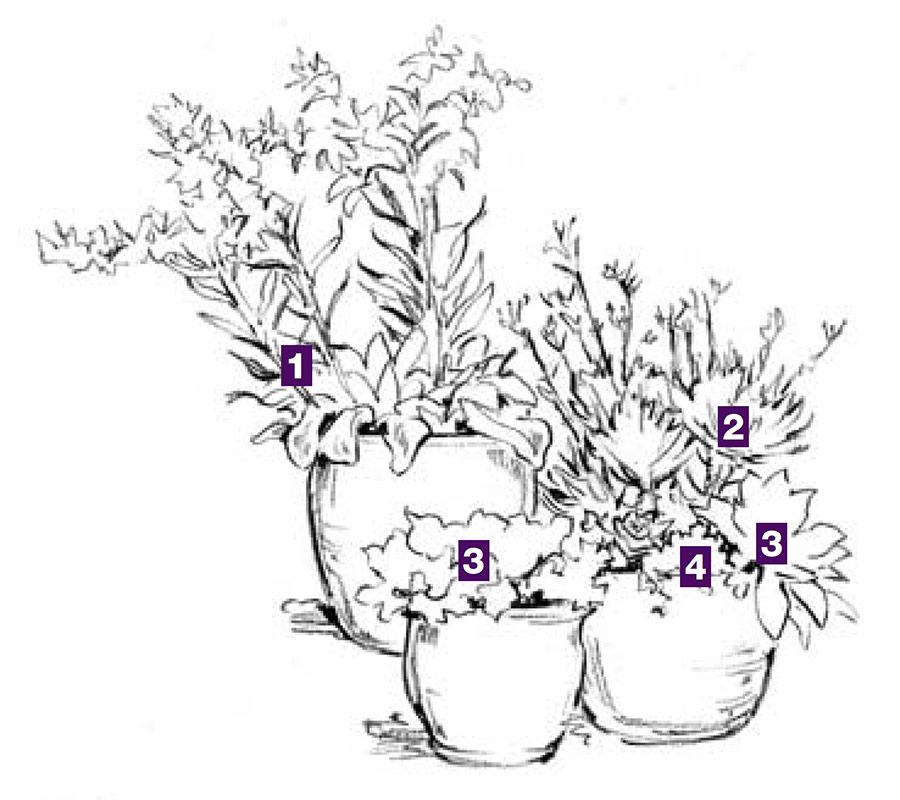Summer time is the season all gardeners await. The intense solar and heat climate sign the beginning of the showiest time of yr, and nowhere is that this pleasure extra evident than with container gardening. Backyard shops are overflowing with crops and pots in each colour, measurement, model, and form. Whether or not you lean towards tropicals or are keen about succulents, summer season is the season to point out off your abilities. To get you began, we’ve assembled just a few designs by Julie Chai of San Francisco and Riz Reyes of Seattle (for Riz’s designs, see half 2 of this text). We invite you to faucet into their creativity—and to broaden upon their suggestions—to make this your greatest container season but.
A pot ought to go well with its environment
Few sounds are as soothing as streaming water, and a container that accompanies it should even be light. Right here, an upright blue-green agave and a variegated euphorbia mimic the fountain’s column, whereas a cascading candy potato vine and a calibrachoa resemble spilling water.
- ‘Ray of Gentle’ variegated foxtail agave (Agave attenuata ‘Ray of Gentle’, USDA Hardiness Zones 9–11)
- ‘Tasmanian Tiger’ euphorbia (Euphorbia characias ‘Tasmanian Tiger’, Zones 7–10)
- ‘Candy Caroline Gentle Inexperienced’ candy potato vine (Ipomoea batatas ‘Candy Caroline Gentle Inexperienced’, Zone 11)
- Superbells® Yellow Chiffon calibrachoa (Calibrachoa ‘USCALI4021’, annual)
Join the dots
All planters want a focus. Right here, the wispy fountain grass does the trick with out bullying its neighbors. What makes this planting much more fascinating, nonetheless, is the best way the golden plumes of the grass decide up on the yellow of the yarrow and zinnia whereas on the identical time set up a reference to the smooth leaves of the licorice plant.
- ‘Moonshine’ yarrow (Achillea ‘Moonshine’, Zones 3–8)
- Tsavo™ Yellow Ice creeping zinnia (Sanvitalia procumbens ‘Tsavo Yellow Ice’, annual)
- Purple bunny tails fountain grass (Pennisetum messiacum, Zones 7–9)
- Licorice plant (Helichrysum petiolare, annual)
Quiet compositions for quiet areas
The location of containers will be as essential because the crops themselves. The quiet colours of the compositions listed here are effectively suited to a seating space, however the thrilling tapestry of textures ensures that the vignette is something however boring.
- Echeverias (Echeveria spp., Zones 9–11)
- Agave (Agave attenuata sp., Zones 7–11)
- ‘Glacier Blue’ spurge (Euphorbia characias ‘Glacier Blue’, Zones 7–10)
- Creeping Jenny (Lysimachia nummularia*, Zones 4–8)
- Lambs’ ears (Stachys byzantina, Zones 4–8)
- ‘Silverdust’ dusty miller (Senecio cineraria ‘Silverdust’, annual)
Tip
Nothing is extra irritating than having one plant that requires extra water than one other in the identical pot. In such a case, it’s almost not possible to maintain each plant pleased and looking out good, particularly within the warmth of summer season. Learn tags rigorously, and choose your crops based mostly on their water and fertilizing wants as a lot as their appears to be like.
Black is again
Black crops lend containers a way of journey, particularly when the companion crops are gentle coloured. However the placement of dark-leaved crops is crucial. The black crops in these two containers create a zigzag impact, breaking apart the mass of softer pink and purple crops whereas giving every of them a lifetime of their very own.
- ‘Platinum Wallaby’ mulla mulla (Ptilotus ‘Platinum Wallaby’, Zones 9–10)
- Vertigo® pearl millet (Pennisetum purpureum* ‘Tift 8’, Zones 8–11)
- Supertunia® White Russian petunia (Petunia ‘Kerivoryvein’, annual)
- ‘Candy Caroline Bewitched’ candy potato vine (Ipomoea batatas ‘Candy Caroline Bewitched’, Zone 11)
- ‘Heatwave Glitter’ salvia (Salvia microphylla ‘Heatwave Glitter’, Zones 6–9)
- ‘Palace Purple’ heuchera (Heuchera micrantha ‘Palace Purple’, Zones 3–8)
- ‘Everillo’ sedge (Carex oshimensis ‘Everillo’, Zones 6–9)
- Fan flower (Scaevola aemula cv., annual)
Tip
Embrace dark-leaved crops with warning. Deep burgundy, black, or purple foliage works effectively to anchor a planting. However watch out: Too many black-hued crops can render a container uninteresting and drab. Combine them with light-colored crops to diffuse the drama.
Steadiness flowers and foliage
Using foliage is crucial in containers the place flowering crops have comparable habits. The positioning of the sedge right here separates the blousy lobelia and euphorbia, whereas the ample silver leaves of a draping snow-in-summer completes the ensemble. The splash of blue, which breaks up the dominant silver-whites, provides a pleasant shock.
- Breathless™ White euphorbia (Euphorbia hypericifolia ‘Balbrewite’, annual)
- Amazon Mist™ sedge (Carex comans ‘Amazon Mist’, Zones 7–9)
- Laguna™ Sky Blue lobelia (Lobelia erinus ‘Loboudtis’, annual)
- Snow-in-summer (Cerastium tomentosum, Zones 3–7)
Camouflage undesirable parts
What higher approach to detract from the legginess of a yellow conebush than to plant one thing vibrant coloured in entrance of it? The kangaroo paw attracts consideration away from the underside of the conebush whereas additionally selecting up the colour of its stems, permitting the conebush to point out off its greatest characteristic: the leaves. A vibrant, compact, low-growing sedum finishes the planting with extra distinction.
- ‘Safari Goldstrike’ yellow conebush (Leucadendron ‘Safari Goldstrike’, Zones 9–11)
- Kangaroo paw (Anigozanthos sp., Zones 10–11)
- Lemon Coral™ sedum (Sedum rupestre ‘Lemon Coral’, Zones 7–11)
Think about all colours
This colour mixture of crops may, at first look, seem incongruous, with the purple-pink angelonia conflicting considerably with the gold-and-red calibrachoa. However upon nearer inspection, all of the crops work completely collectively. The fuchsia-purple of the angelonia enhances the underside of the heuchera leaves, whereas the remainder of the heuchera pulls within the golden colours of the calibrachoa and sedge to create a harmonious complete.
- Orange New Zealand sedge (Carex testacea, Zones 7–9)
- Archangel™ Raspberry angelonia (Angelonia angustifolia ‘Archangel Raspberry’, annual)
- Superbells® Apricot Punch calibrachoa (Calibrachoa ‘USCALI4138’, annual)
- ‘Kassandra’ heuchera (Heuchera ‘Kassandra’, Zones 4–9)
Tip
“Shade” is a broad time period, so it’s essential to know what sort you might have earlier than planting or chances are you’ll danger the well being of the plant. The intense shade of an east-facing space affords extra plant choices than dappled- or deep-shade areas. Research the world during which you need to plant, then buy crops accordingly.
Exhibit the shapes of succulents
The rosettes of the 2 blue-pink echeverias alone would have appeared elegant atop a easy aqua container, however the addition of the lengthy, darker inexperienced string of bananas provides a contact of distinction, bringing out the perfect of each crops’ shapes.
- ‘Perle Von Nurnberg’ echeveria (Echeveria ‘Perle von Nurnberg’, Zones 9–11)
- ‘Girl Aquarius’ echeveria (Echeveria ‘Girl Aquarius’, Zones 9–11)
- String of bananas (Senecio radicans, Zones 8–10)
Brighten a shady area
Chartreuse leaves and variegated foliage are go-to parts for brightening a shady space, however the choice of a flax lily and a lime-hued sedge proves that not any previous form will do. The juxtaposition of pointy leaves, mounding blades, and the dangling, earring-like blossoms of the flowering maple remodel this straightforward shade buster right into a container with a sunny disposition.
- Variegated flax lily (Dianella tasmanica ‘Variegata’, Zones 8–11)
- ‘Everillo’ sedge (Carex oshimensis ‘Everillo’, Zones 6–9)
- Fortunate Lantern® Tangerine flowering maple (Abutilon ‘NUABTANG’, Zones 8–11)
Tip
Incorporate one conventional plant right into a container that options unusual crops. You’ll be stunned at how a tried-and-true plant can tackle an entire new look when paired with one thing uncommon. Strive it: You’ll by no means take a look at that previous geranium or decorative grass the identical method once more.
Pair crops with pots
A artistic ensemble of silver, blue, and purple succulents in harmonious ceramic pots produces a front-door scene with model. Whereas nearly any array of drought-tolerant crops can be interesting, this grouping steps up the artistry by pairing pots and crops that convey out the perfect of each other’s colours.
- ‘Afterglow’ echeveria (Echeveria ‘Afterglow’, Zones 9–11)
- Blue chalk sticks (Senecio mandraliscae, Zones 10–11)
- Echeveria (Echeveria cv., Zones 9–11)
- ‘Cape Blanco’ sedum (Sedum spathulifolium ‘Cape Blanco’, Zones 5–9)
*These crops are thought-about invasive in some areas. Please verify invasiveplantatlas.org or your state’s record of invasive crops for extra info.
Images: Lynn Felici-Gallant
Illustrations: Elara Tanguy
